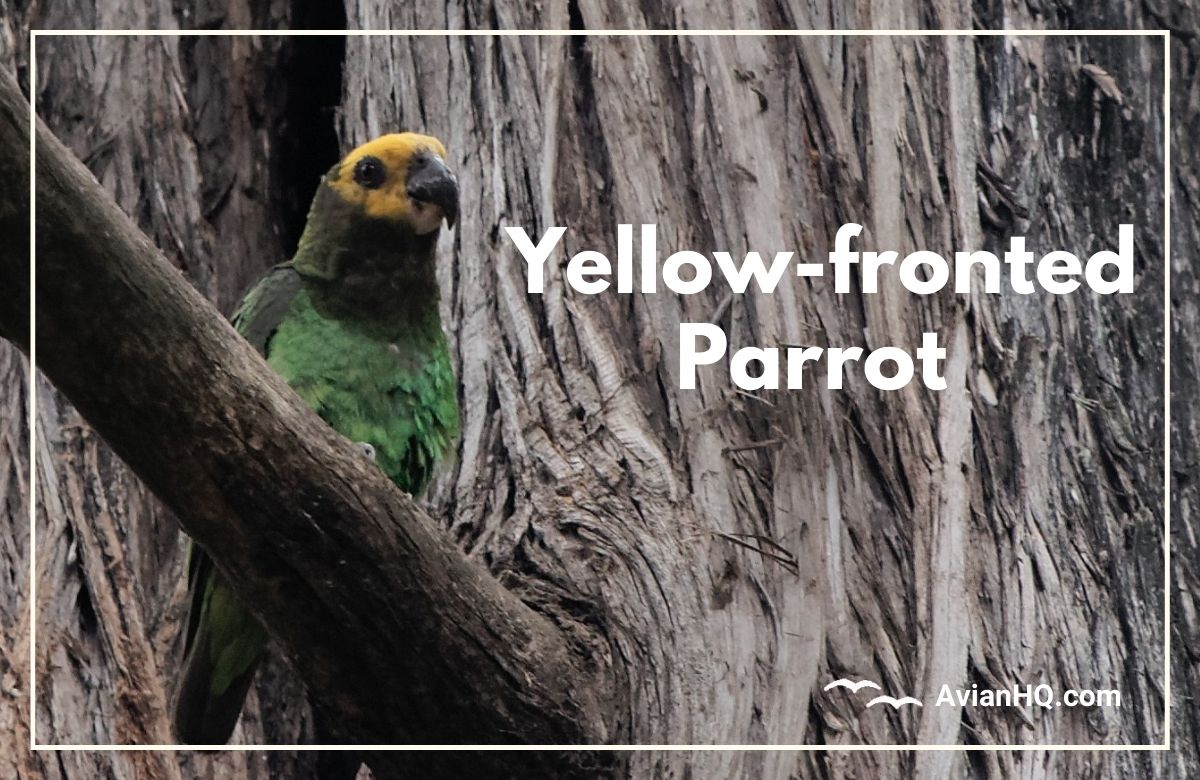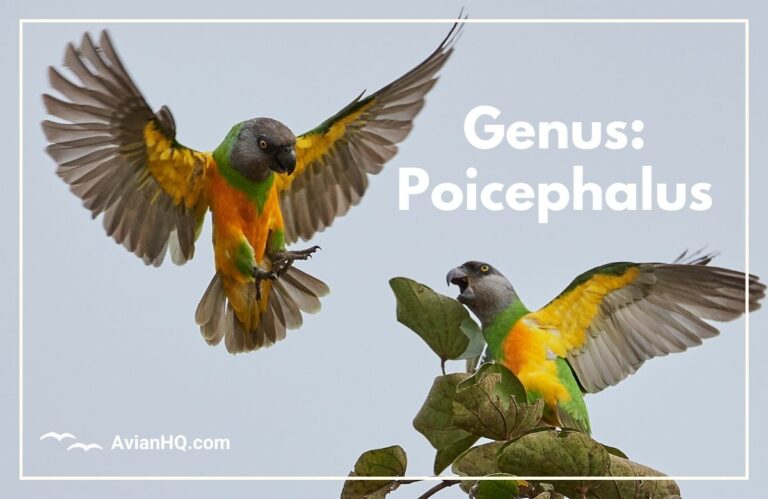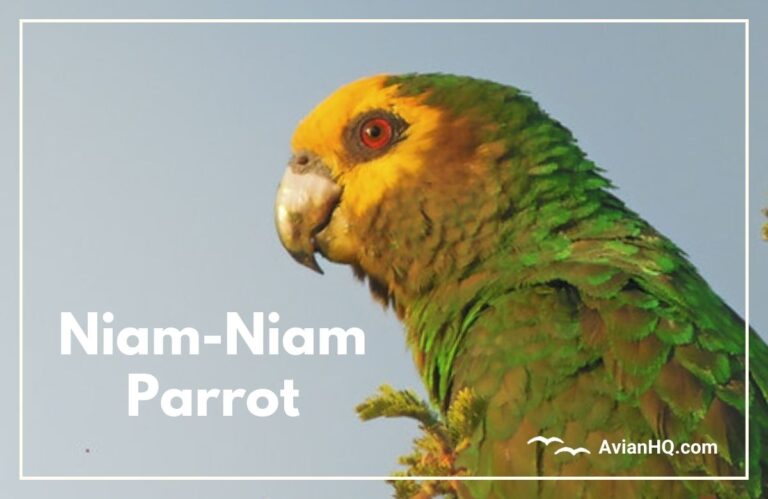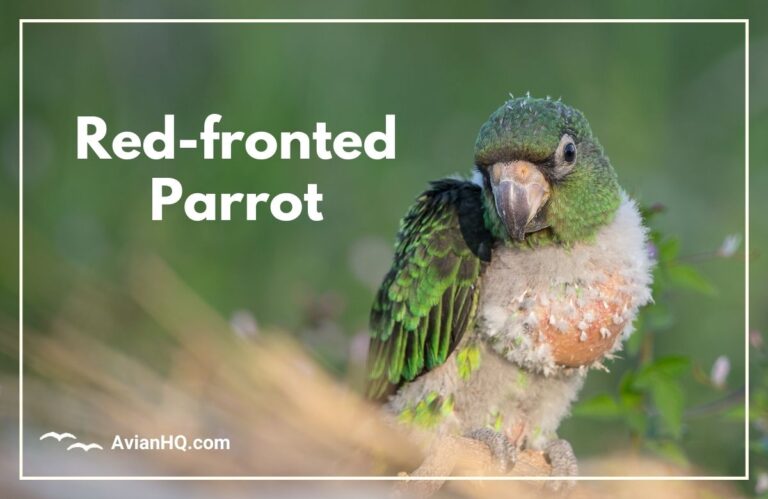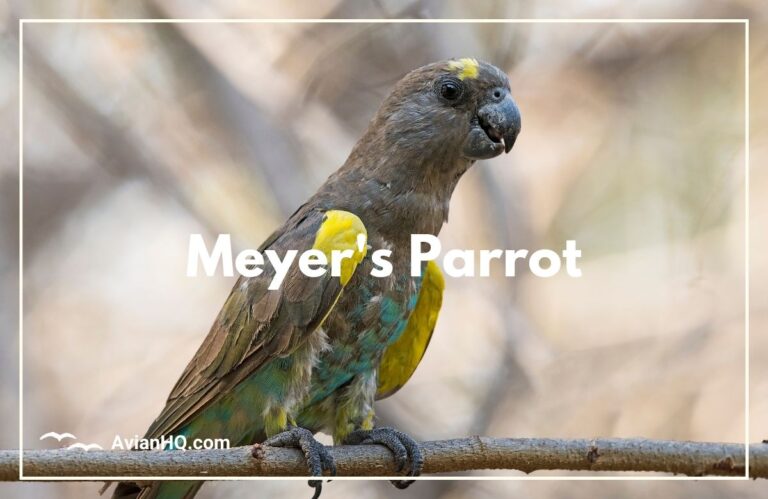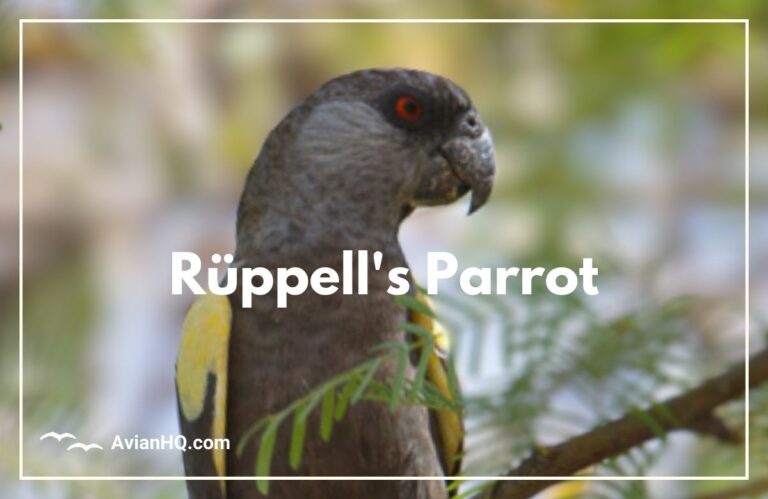Yellow-fronted Parrot (Poicephalus flavifrons)
As you gaze out over the lush forests of the Ethiopian Highlands, a flash of bright yellow catches your eye. A vibrant parrot with a golden yellow face and forehead lands gracefully on a nearby tree branch. This brightly colored bird is the Yellow-fronted Parrot, a beautiful species endemic to these African mountains.
“The Yellow-fronted Parrot’s bright colors and high elevation habitat make it a unique parrot.”
While parrots can be found across warmer regions worldwide, the Yellow-fronted Parrot stands out for being adapted to cooler climates at higher elevations. This parrot inhabits montane forests and woodlands at elevations from around 5,900 feet to 9,800 feet (1,800 to 3,000 meters) above sea level. Here, the temperatures are milder than the hot lowland areas where most parrots live.
The Yellow-fronted Parrot weighs between 5 to 7 ounces (140 to 205 grams) and measures about 11 inches (28 centimeters) long. It’s vibrant yellow forehead and facial feathers contrast with green upper body plumage. The tail feathers are olive-brown in color. The parrot uses it’s curved grey-brown bill to crack open seeds and nuts. It’s strong feet and legs allow it to climb and perch with ease high up in the mountain trees.
This medium-sized parrot plays an important role in it’s mountain ecosystem. As you learn more about the natural history of this species, you’ll discover what makes the Yellow-fronted Parrot so well adapted to the Ethiopian Highlands.
History and Taxonomy
The Yellow-fronted Parrot remained unknown to science until the mid-19th century. This highland species was first described in 1845 by the German naturalist Eduard Rüppell after his travels in what is now Ethiopia. He named the parrot Poicephalus flavifrons, with the species name derived from Latin words meaning “yellow” (flavus) and “forehead” (frons). This scientific name clearly describes the parrot’s most striking feature – it’s bright yellow crown.
For over a century, the Yellow-fronted Parrot was considered a single species with no identified subspecies. More recently, some experts proposed dividing the birds into two separate subspecies based on slight variations:
- P. f. flavifrons: The nominate subspecies found around Lake Tana and central Ethiopia. It has a pure yellow forehead and face.
- P. f. aurantiiceps: A potential second subspecies reported from southwestern Ethiopia. In these birds, some of the yellow feathers on the face are replaced with orange.
However, more research is still needed to confirm whether these represent two distinct subspecies rather than simple regional variations. Currently, most authorities continue to categorize the Yellow-fronted Parrot as a monotypic species with no divided subspecies.
The Yellow-fronted Parrot is one of nine species within the genus Poicephalus, all of which are African parrots characterized by stocky bodies and short tails. The Yellow-fronted Parrot is the only highland montane species within this genus, as the others inhabit lowland forests and savannas further south on the continent.
Physical Appearance
The Yellow-fronted Parrot is a medium-sized parrot measuring about 11 inches (28 centimeters) long from the tip of it’s tail to the end of it’s bill. It weighs between 5 to 7 ounces (140 to 205 grams).
Its plumage is mostly green above with more yellowish-green underparts. The most striking feature is the bright golden yellow forehead, crown, cheeks and throat. The feathers on the top portion of the breast also have yellow tips. The uppertail coverts and tail feathers are olive-brown.
The parrot’s bill is horn-colored grey with a darker grey upper mandible. The bare skin around the eyes and eyelids is pale grey, and the irises of the eyes are orange-red. The legs and zygodactyl feet are greyish-brown.
Some individual differences in plumage exist between the proposed subspecies P. f. aurantiiceps and nominate P. f. flavifrons. The former shows more orange tones mixing into the yellow facial feathers. However, much remains unknown about whether distinct separate populations exist.
Juvenile Yellow-fronted Parrots resemble the adults but show some key differences. Their green body plumage appears less vibrant. The yellow feathers on the face are duller as well with an olive overwash. The irises of the eyes are typically brown rather than orange-red. As the birds mature over their first year, their adult colors will gradually emerge.
The Yellow-fronted Parrot shares some visual similarities with the Cape Parrot of southern Africa. Both have predominantly green bodies with vivid yellow feathers on the head and shoulders. However, the Cape Parrot lacks a distinct yellow forehead patch. The two species are not closely related, having adapted independently to life in African mountain forests.
Habitat and Distribution
The Yellow-fronted Parrot is endemic to the Ethiopian Highlands in Africa. It’s range is restricted to remnant montane forests and woodlands at elevations between approximately 5,900 and 9,800 feet (1,800 and 3,000 meters).
The nominate subspecies P. f. flavifrons occupies higher elevation habitats in northern Ethiopia, particularly in the highlands near Lake Tana. It also occurs in forests surrounding the capital city Addis Ababa in central Ethiopia.
The proposed second subspecies P. f. aurantiiceps has a more limited distribution in southwestern Ethiopia. It is chiefly found near the towns of Masango and Gilo River where patches of suitable forest habitat remain.
Throughout their narrow endemic range, Yellow-fronted Parrots inhabit a diversity of highland habitats. These include natural forests dominated by conifers like juniper and podocarpus trees. They also utilize secondary forests of native figs and acacias as well as cultivated areas such as eucalyptus woodlots and tree plantations.
The dependence of this species on vulnerable remnant forests highlights the need to protect these declining habitats across the rugged Ethiopian Highlands. Without conservation of it’s specialized highland ecosystem, the long-term survival of the Yellow-fronted Parrot could be at risk. Going forward, more research is essential to estimate total population sizes and determine the extent of protected lands across it’s current potential range.
Diet and Feeding
The Yellow-fronted Parrot is herbivorous and consumes a wide variety of plant matter, including buds, seeds, nuts, fruits, berries, and vegetables. It’s strong bill is adapted for cracking into seeds and woody seed pods.
This parrot feeds on seeds and fruits from native highland trees like juniper, podocarpus, and fig trees. Food plants include Ethiopian olive trees (Olea europaea cuspidata) and rose apple (Dovyalis abyssinica). The parrots also forage for vegetables, likely feeding on cultivated crops at times. Specific food preferences may vary across their geographic range based on habitat and food availability.
The Yellow-fronted Parrot typically searches for food while perched or climbing through trees and shrubs. It grips branches securely with it’s zygodactyl feet, using the long claws to grasp plant stems. The birds may feed individually but more often forage in pairs or small flocks of up to 20 individuals.
Flocks exhibit flight patterns moving from one feeding ground patch to another across the landscape. They are highly vocal, calling to coordinate foraging movements across habitat fragments. Their high-elevation habitat likely concentrates feeding activity within a relatively compact home range across mountain forests and woodlands compared to lowland parrot species.
At night, the parrots congregate in communal roosting spaces at traditional nesting and sleeping trees. Competition safe spots likely concentrate food resources, contributing to the birds’ social roosting behaviors. Their unique adaptations allow exploitation of food in cold highland habitats avoided by most other African parrots. Protecting both roosting and feeding grounds will be vital for preserving Yellow-fronted Parrot populations into the future.
Breeding and Reproduction
There is still much to learn about the specifics of Yellow-fronted Parrot breeding ecology and nesting behaviors. As cavity nesters, they likely utilize tree holes similar to other parrots. Specific clutch sizes have not yet been documented in natural nest sites.
Based on the biology of related Poicephalus parrots, Yellow-fronted Parrots potentially lay clutches of 3-5 eggs. The female likely incubates the eggs for 22-28 days before they hatch. After hatching, both parents share brooding duties to keep chicks warm.
Nestling parrots typically fledge at 6-8 weeks old. However, the exact timeframe is uncertain for wild Yellow-fronted Parrots. More observations are needed on breeding chronology and development in natural habitat.
In captivity, Yellow-fronted Parrots first bred around 2010 in European aviaries. Captive birds utilize nest boxes approximately 12 inches wide by 14 inches deep by 10 inches high (30 x 35 x 25 cm). The entrance hole measures around 3 inches (8 cm) across. In Germany’s Jena Zoo, a pair was observed breeding in December following a courtship period in November.
The female laid three eggs at intervals of 2-3 days. She incubated them for about 28 days while the male regularly fed her in the next box. The altricial chicks hatched over 2-3 days, initially weighing 0.2 ounces (6 grams) and measuring 2 inches (52 mm) long. Both parents regurgitated food for the rapidly growing chicks.
This first documented captive breeding confirms the potential for successful reproduction when good conditions are met. Continued study of both wild and captive populations will shed more light on habitual breeding behaviors. Monitoring reproductive rates over time could also reveal impacts from environmental factors like habitat loss, climate change or human disturbance.
Behavior and Ecology
The Yellow-fronted Parrot exhibits a mix of social and solitary behaviors. They may be observed alone or in pairs, but more commonly travel in small flocks of up to 20 birds. They associate closely with Black-winged Lovebirds, which share parts of their highland habitat. Mixed foraging flocks move together between food resource patches across the montane landscape.
These parrots display swift direct flight patterns thanks to their tapered wings and streamlined body shape. Their flight agility aids navigation through steep mountain terrain across fragmented woodlands. Strong claws allow them to readily climb and perch across trees and rocky cliffs.
Roosting communally in traditional nesting trees at night likely offers safety advantages. Competition for safe cavity nest sites concentrates breeding populations spatially. The parrots exhibit year-round, long-term site fidelity to ancestral roosting locations. Their social bonds also extend to feeding grounds, where flocks concentrate nutritional resources effectively.
The remote highland distribution makes studying wild Yellow-fronted Parrots challenging. Thus, much about their ecology and habits remains undiscovered. For example, details on lifespan, predation pressures, and seasonal movement habits are lacking. Ongoing monitoring across their range will reveal more about ecological niches allowing their specialized adaptation.
What is clear is that deforestation across their limited habitat threatens long-established ecological relationships. Preserving sufficient undisturbed forest is vital so Yellow-fronted Parrots can maintain behavioral traditions allowing exploitation of variable food sources across the landscape. Safeguarding natural communal resources helps ensure positive social dynamics facilitating future reproduction.
Conservation Status
The Yellow-fronted Parrot is currently classified as Least Concern on the IUCN Red List of Threatened Species. However, it’s remote habitat and lack of monitoring create difficulty determining accurate population sizes and trends.
While the overall population is presumed stable, local declines have been observed in areas with significant habitat loss. For example, decreases are documented in Bale Mountains National Park and Wondo Genet in Ethiopia. The species likely remains relatively abundant in well-protected habitats, with flocks of 50 or more birds still reported from some forested sites.
Major threats stem from deforestation across the Yellow-fronted Parrot’s limited endemic range in Ethiopia. Logging of native Juniper, Podocarpus, and Acacia trees removes vital nesting cavities and food sources. Expanding agriculture and tree clearing for firewood, construction and charcoal production also eliminate crucial habitat.
Additionally, parrots face persecution as crop raiders when attempting to utilize cultivated fields near remnant woodlots. As natural habitat shrinks, conflict with farmers will likely increase without preventative measures.
While legal protections exist in some protected areas like Abijatta-Shala and Bale Mountains National Parks, much habitat remains unprotected. Habitat preservation projects aimed at connecting fragmented forests through ecological corridors could aid conservation. Continued research is essential to identify key sites needing safeguarding to maintain viable breeding populations.
In captivity, the Yellow-fronted Parrot is listed under CITES Appendix II, restricting commercial trade due to it’s limited distribution and vulnerability to extinction risk. Successfully maintaining the species long-term will depend on coordinated efforts between captive breeding and in situ habitat protections.
Cultural Significance
The Yellow-fronted Parrot has minimal cultural significance within it’s endemic range in the remote Ethiopian Highlands or around the world.
While colorful parrots often become celebrated cultural symbols or popular pets, the Yellow-fronted Parrot has largely avoided both roles. It’s remote montane habitat likely shielded it from extended interaction with indigenous human groups over history. And it’s recent discovery by Western science delayed recognition beyond specialty ornithological circles.
Within Ethiopia, some native populations likely knew the species as a minor crop pest consuming cultivated grains and fruits at field edges. There is no evidence native tribes held the parrot as a spiritual symbol or significant cultural icon. As a relatively obscure endemic species, it has not been promoted as a national symbol or appeared on currency and stamps as seen with some iconic birds.
However, some early Western explorers took interest in the graceful mountain parrot. In recent decades, ecotourism activities focused on endemic Afroalpine birds bring specialized birdwatchers hoping to glimpse elusive species like the Yellow-fronted Parrot. As climate change and development increase human pressures across the Ethiopian Highlands, conserving habitats essential for this parrot may grow importance culturally and economically.
While not embedded extensively in widespread human cultural traditions yet, the Yellow-fronted Parrot remains a significant species as a beautiful component of Ethiopian biodiversity. Protecting populations of the species and it’s endemic habitat upholds conservation values important within segments of modern societies around the globe.
Conclusion
The Yellow-fronted Parrot is truly a unique bird perfectly adapted to the Ethiopian Highlands of Africa. As the only Poicephalus parrot occupying such a high elevation montane niche, it fills an important ecological role. It’s bright colors and high altitude habitat set it apart from more widespread lowland African parrots.
Weighing just 5-7 ounces (140-205 grams) with 11 inch (28 cm) length, the parrots sport a vibrant yellow forehead and facial feathers that offset green upper plumage. They forage for vegetable matter in small flocks, gripping native trees readily with swift climbing abilities. though highland living varies seasonal extremes, communal roosting offers competitive advantages securing resources.
Breeding likely proceeds similarly to related species, with females incubating 3-4 eggs for around a month while males provision nest sites. After fledging, pairs coordinate to feed offspring until independence. Their complex behaviors speak to tight evolutionary relationships with endemic forest habitats.
Unfortunately, Yellow-fronted Parrots now face threats as logging and land conversion constrict available habitat. Their limited range provides no buffer against population declines in degraded areas. While overall extinction risk remains low currently, proactive habitat conservation efforts deserve prioritization across remaining old growth forests.
In many ways the Yellow-fronted Parrot epitomizes Ethiopia’s special biodiversity found nowhere else globally. Protecting this unique species by maintaining it’s habitat upholds the nation’s natural heritage. As human development increases across rare Afroalpine ecosystems, policy changes balancing wildlife needs will become essential long-term.

